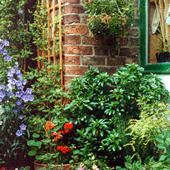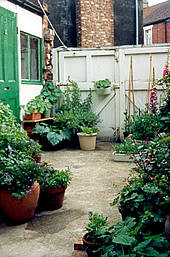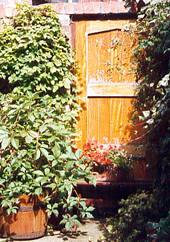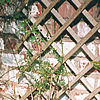My first garden was what I once heard described as a 'yarden' - that
concrete area behind many an urban Victorian house - what we Yorkshire
folk would call a yard, and what in estate agents' details is invariably
knocked up a notch or two by being referred to as a 'courtyard' - even
if the 'courtyard' contains only a couple of dustbins and a washing line,
as ours did before I filled it full of plants.
The yard garden
My yard was attached to a small terraced house in a large area of similarly
terraced houses, a network of small streets and back lanes. The front
of the house faced south, which was pleasant, but this unfortunately meant
that it blocked out most of the light from the small yard behind it, leaving
it mainly in the shade.
It was only around 6 metres long, with the narrowest part near the house
only about 2 metres wide, the wider part past the end of the kitchen about
3 metres wide, in terms of planting space, as the rest of the width was
taken up by a wooden shed.
Improving the boundaries
The yard been used as car parking space, and had double gates at the
end. These were rotting, and held together with an old washing line. Not
a beautiful view. Crucial to the development of my tiny yard garden was
the brick wall that was built here by my stepfather,
to replace these wooden gates. It included a sturdy lockable door.
The yard suddenly felt enclosed, and secure, and certainly, if you're
going to look out and find a boundary a few metres away, better that
it's a well-built brick wall than a wooden gate that appears to be rotting
and about to collapse.
Starting to plant
The planting began from humble beginnings; a small cutting of a honeysuckle
Lonicera japonica 'Halliana' from my mother's garden, and a few herbaceous
plants she'd divided up. The first things I bought were two small evergreen
shrubs, a Euonymous ovatus 'Aureus' and a Choisya
ternata.
It took me a long while to realise that I couldn't grow everything I wanted
in this area of shade between the houses, and
that my visions of wisteria hanging over walls had to be modified. The
plants that truly flourished were the ones that could cope with shade.
Protected places
At the sunny end of the yard I grew from seed a pot of Thunbergia alata
(Black-eyed Susan), which grew up a tripod of canes, and made a stunning
show. I've never managed to grow it as well since, in my current garden.
Possibly the smallness of the yard meant this tender plant was perfectly
protected from cold and wind. As I had such a small area to look after
it also meant the plants got a lot of individual attention.
This demonstrates the advantages of the tiny yard garden. If you have
fewer plants you can look after them better. And you can exploit the benefits
of the 'microclimate' of a sheltered yard, with all those bricks retaining
the heat and gently keeping the space near them warm.
Pest problems
I did find it increasingly difficult to control the balance of nature
in the rather unnatural backyard environment. In the urban yarden the
main problem may be a serious slug and snail
problem, a result of the lack of natural predators. Hedgehogs are good
slug/snail predators, apparently, but unfortunately I don't think they
can scale 2-metre high brick walls.
Even in gardens that have predators, there are always too many slugs and
snails. At least if you have a smaller space you can comfort yourself
with the fact that you probably have a smaller number of slugs and snails
. . .
One organic idea I've read about but never tried is to use beer traps,
basically saucers of beer at strategic points, which attract the slugs,
and they apparently then drown. Drowning in beer is probably one of the
more pleasant ways to meet your end, I guess. I never tried beer traps
myself, as disposing of dead slugs in stale beer didn't really appeal.
Life's hard enough. In my current garden I've found collecting
them up on damp nights works as well as anything else. Please don't
use slug pellets, which are nasty, noxious, and not necessary.
Cats are often cited as pests. Our ex-next-door
neighbour, who liked to pick fights with us, was so deeply upset by cat
doings in her yard that she used to throw the offending turds back over
the wall. This didn't seem fair as she couldn't be sure they came from
our cats, but I resisted the urge to throw them back over again, with
an attached note, as it could have got rather silly.

A corner of the yard in 1990.

The gates at the end of the yard in 1989, before the end wall was built.

With the gates replaced by a wall and a door, and covered with climbers.

